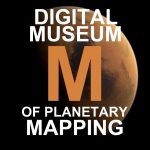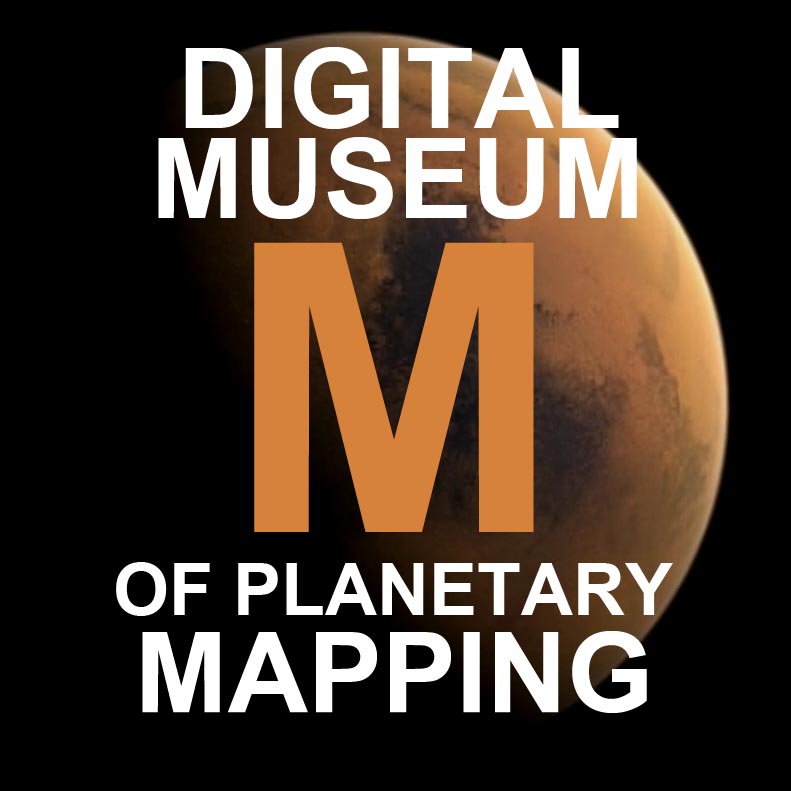The Digital Museum of Planetary Mapping
The Digital Museum of Planetary Mapping is maintained by the International Cartographic Association Commission on Planetary Cartography.
Contact email: planetarymaps[at]gmail.com.
Editor: Henrik Hargitai
Co-Editors: Ton Lindeman, Mateusz Pitura
The International Catalog of Planetary Maps
This database provides bibliographic and image data of planetary maps published internationally from the beginning (1600 to today, updated regularry. The database contains data on maps published in scientific, educational and commercial publications.
Catalog curator: Henrik Hargitai
- Contributors:
- Ton Lindemann (historic map manuscripts)
- Mateusz Pitura (research and updates)
- Mátyás Gede (coding and structure)
- Chuck Wood (Lunar maps and globes)
Citations
- Hargitai H. I. , M. Pitura 2018 International Catalog of Planetary Maps 1600–2017. 49th Lunar and Planetary Science Conference 2018 (LPI Contrib. No. 2083)
- Hargitia HI, Pitura M 2018 Four Centuries of European Planetary Mapping: Towards Mapping for New Human Surface Operations European Planetary Science Conference EPSC2018-258. Berlin, 2018. szeptember
Supporters:
- NASA Postdoctoral Program (NPP) at the Ames Research Center, administered by ORAU and by Universities Space Research Association through a contract with NASA.
- Europlanet/VESPA, the European Union’s Horizon 2020 research and innovation programme grant agreement No 654208
- International Cartographic Association
The Integrated Database of Planetary Features (Catalog version)
Name: Integrated Database of Planetary Features
Description
This database is a collection of references and data of catalogs (databases) of planetary geologic features of any Solar System objects. The data provided are either in digital table format or GIS-ready shapefiled.
Citation
Henrik Hargitai 2016 Metacatalog of Planetary Surface Features for Multicriteria Evaluation of Surface Evolution: the Integrated Planetary Feature Database. DPS 48/ EPSC 11 Meeting #426.23, Pasadena, CA.
Editor Henrik Hargitai
Supporters
- NASA Postdoctoral Program (NPP) at the Ames Research Center, administered by ORAU and by Universities Space Research Association through a contract with NASA.
- Europlanet/VESPA, the European Union’s Horizon 2020 research and innovation programme grant agreement No 654208.
What’s included and what’s not
The Museum keeps both historical and recent maps.
The maps published within the USGS planetary mapping series are typically not included in the museum but they are included in the catalog. Thematic maps that were made to illustrate a specific theme for a research paper are not included; however, thematic maps produced for a research paper that show a global phenomenon or are generic maps of a region, are included in the collection.
We have started to add dynamic maps (GIS, webmaps, animgif, etc.).
Copyright Disclaimer
The editor and publisher gratefully acknowledge the permission granted to reproduce the copyright materials in the Digital Museum of Planetary Mapping.
Russian / Cyrillic maps were provided or scanned / photographed at the MIGAiK Extraterrestrial Lab Library, Moscow, with permission, between 2001 and 2011.
Hungarian maps were provided by the Eötvös Loránd University Cosmic Materials Space Research Group, with permission.
Scans of a part of international historic maps were provided by Ton Lindemann, with permission.
Maps published in the USA before 1923 have expired copyrights and are in the public domain. In addition, works published before 1964 that did not have their copyrights renewed 28 years after first publication year also are in the public domain.
Manuscripts from authors who died before 1945 are in the public domain as of 2015.
Works First Published Outside the U.S. before 1923 are in the public domain.
All NASA publications are in the public domain, as NASA is a government agency. Similarly, USGS maps have no copyright.
Every effort has been made to trace copyright holders and to obtain their permission for the use of copyright material. We apologize for any errors and would be grateful if notified of any corrections that should be incorporated in future revisions of this website.
Permissions
The maps in our collection were not made by us, they are all third party products.
Copyrighted maps: Please contact the original copyright holders. We cannot issue any republication rights from our websites.
Non-copyrighted/public domain maps whose print version was scanned or photographed by us: Permission is granted for noncommercial use. For commercial use, contact us.
Non-copyrighted/public domain maps with original pdf or original digital image: Probably no permission is needed, however, we advise you to contact the authors.
Rotating Mars intro screen credit: ESA/Hubble (M. Kornmesser & L. L. Christensen)

